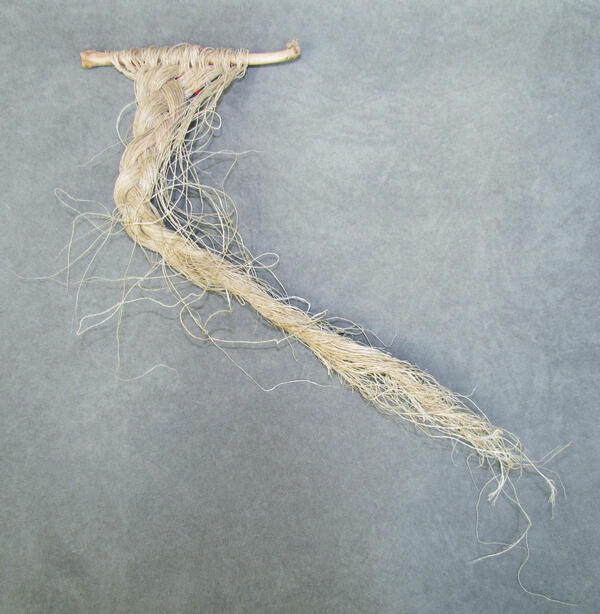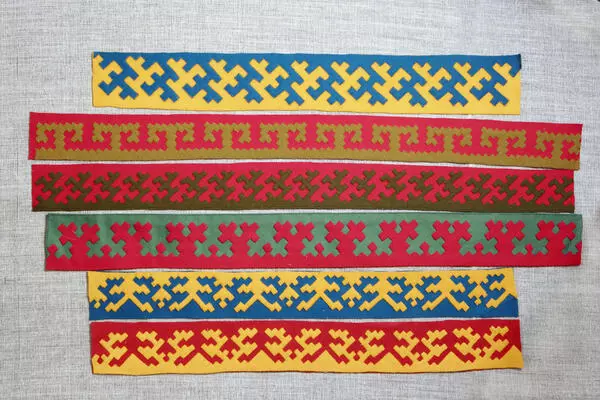The Nenets women traditionally provide their whole families with clothing, it’s them who sew weatherproof suits that protect from cold even during severe winters. Since early times, the Forest NEnets outfit and footwear is made of processed reindeer skins and fur and sewn with special threads. These threads are produced of animal back or legs tendons left after cutting a carcass.
Female reindeer back tendons are considered to be the best fit for upper clothes as they split well for fibers. Reindeer front legs tendons are mostly used for sewing chum roof covers and summer boots because these threads are thicker and more practical. Making threads takes time and patience. First, tendons are hung by the thick end on a rope for drying. When dried well, they can be stored for a long time. If tendons are overdried, they should be smashed with a hummer before further processing. Then tendons are rubbed: carefully with her fingers, a NEnets woman separates thin fibers and rolls them with her palms against her cheek or her knee so that they are smooth. Every NEnets woman learns how to process reindeer tendons into threads already in her childhood. Thin fibers are rolled together because the thickness should be equal throughout a thread. That is why a thin end of one tendon is connected to a thick end of another one. This work is tedious and takes a lot of patience. To have a required amount of threads by summer, threads are usually made in winter.
The length of threads for clothes is 40–45 cm, they are no thicker than manufactured ones but much firmer. Before sewing, reindeer tendon threads are moisturized with water or saliva. After they get dry, they tighten the seam and it becomes firmer increasing the lifetime of clothing and footwear. Nowadays, the Forest NEnets use manufactured threads too, but gloves and shoes are still made with tendon threads. When get wet, they are not stretched and protect the tight seam from water.
Reindeer tendon threads in the museum exposition were provided by the Forest Nenets Fedosiya Vyllo, a resident of Muravlenko town in Yamalo-Nenets Autonomous Okrug.
Female reindeer back tendons are considered to be the best fit for upper clothes as they split well for fibers. Reindeer front legs tendons are mostly used for sewing chum roof covers and summer boots because these threads are thicker and more practical. Making threads takes time and patience. First, tendons are hung by the thick end on a rope for drying. When dried well, they can be stored for a long time. If tendons are overdried, they should be smashed with a hummer before further processing. Then tendons are rubbed: carefully with her fingers, a NEnets woman separates thin fibers and rolls them with her palms against her cheek or her knee so that they are smooth. Every NEnets woman learns how to process reindeer tendons into threads already in her childhood. Thin fibers are rolled together because the thickness should be equal throughout a thread. That is why a thin end of one tendon is connected to a thick end of another one. This work is tedious and takes a lot of patience. To have a required amount of threads by summer, threads are usually made in winter.
The length of threads for clothes is 40–45 cm, they are no thicker than manufactured ones but much firmer. Before sewing, reindeer tendon threads are moisturized with water or saliva. After they get dry, they tighten the seam and it becomes firmer increasing the lifetime of clothing and footwear. Nowadays, the Forest NEnets use manufactured threads too, but gloves and shoes are still made with tendon threads. When get wet, they are not stretched and protect the tight seam from water.
Reindeer tendon threads in the museum exposition were provided by the Forest Nenets Fedosiya Vyllo, a resident of Muravlenko town in Yamalo-Nenets Autonomous Okrug.





